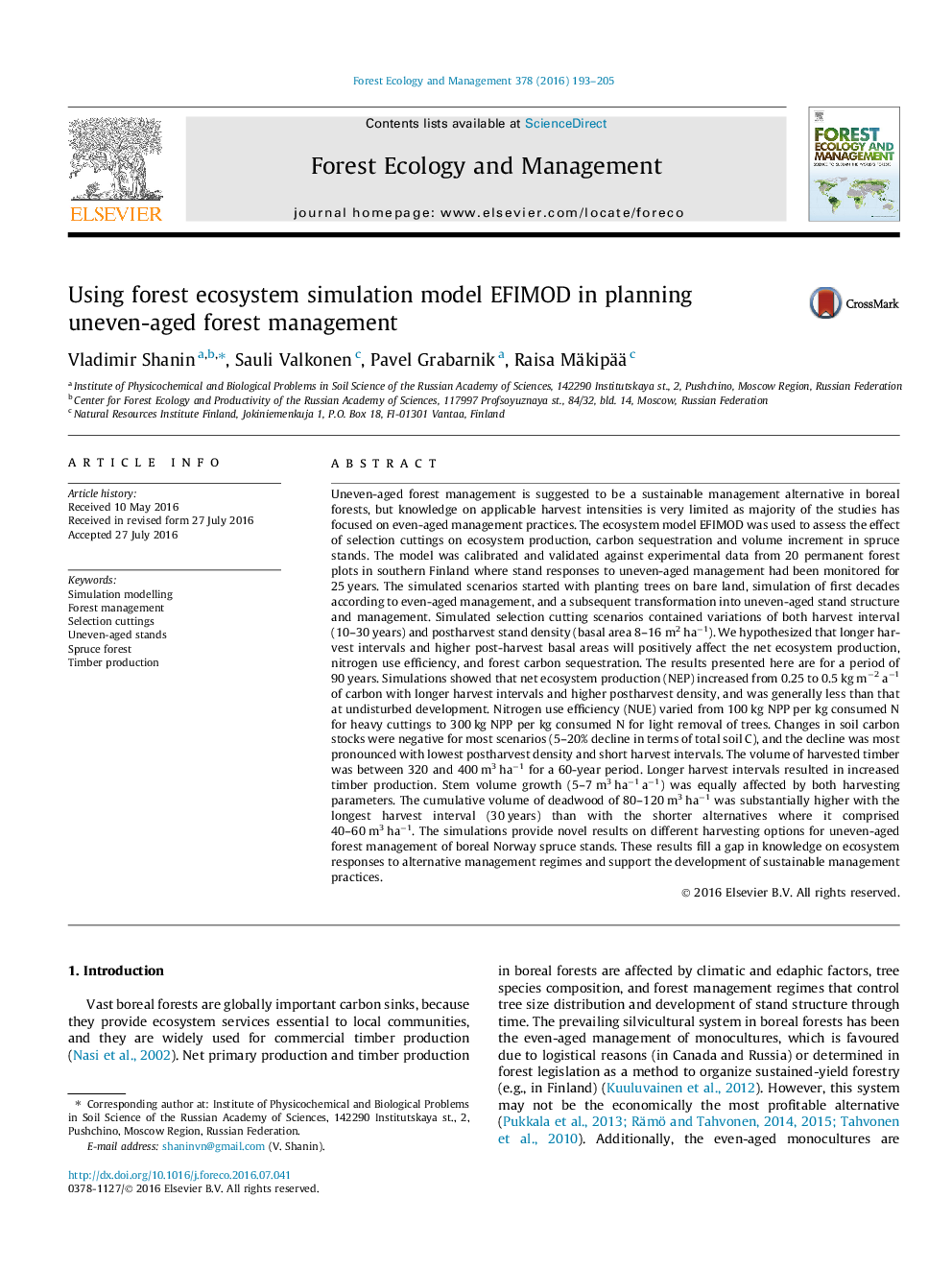| کد مقاله | کد نشریه | سال انتشار | مقاله انگلیسی | نسخه تمام متن |
|---|---|---|---|---|
| 6542049 | 159144 | 2016 | 13 صفحه PDF | دانلود رایگان |
عنوان انگلیسی مقاله ISI
Using forest ecosystem simulation model EFIMOD in planning uneven-aged forest management
دانلود مقاله + سفارش ترجمه
دانلود مقاله ISI انگلیسی
رایگان برای ایرانیان
کلمات کلیدی
موضوعات مرتبط
علوم زیستی و بیوفناوری
علوم کشاورزی و بیولوژیک
بوم شناسی، تکامل، رفتار و سامانه شناسی
پیش نمایش صفحه اول مقاله

چکیده انگلیسی
Uneven-aged forest management is suggested to be a sustainable management alternative in boreal forests, but knowledge on applicable harvest intensities is very limited as majority of the studies has focused on even-aged management practices. The ecosystem model EFIMOD was used to assess the effect of selection cuttings on ecosystem production, carbon sequestration and volume increment in spruce stands. The model was calibrated and validated against experimental data from 20 permanent forest plots in southern Finland where stand responses to uneven-aged management had been monitored for 25 years. The simulated scenarios started with planting trees on bare land, simulation of first decades according to even-aged management, and a subsequent transformation into uneven-aged stand structure and management. Simulated selection cutting scenarios contained variations of both harvest interval (10-30 years) and postharvest stand density (basal area 8-16 m2 haâ1). We hypothesized that longer harvest intervals and higher post-harvest basal areas will positively affect the net ecosystem production, nitrogen use efficiency, and forest carbon sequestration. The results presented here are for a period of 90 years. Simulations showed that net ecosystem production (NEP) increased from 0.25 to 0.5 kg mâ2 aâ1 of carbon with longer harvest intervals and higher postharvest density, and was generally less than that at undisturbed development. Nitrogen use efficiency (NUE) varied from 100 kg NPP per kg consumed N for heavy cuttings to 300 kg NPP per kg consumed N for light removal of trees. Changes in soil carbon stocks were negative for most scenarios (5-20% decline in terms of total soil C), and the decline was most pronounced with lowest postharvest density and short harvest intervals. The volume of harvested timber was between 320 and 400 m3 haâ1 for a 60-year period. Longer harvest intervals resulted in increased timber production. Stem volume growth (5-7 m3 haâ1 aâ1) was equally affected by both harvesting parameters. The cumulative volume of deadwood of 80-120 m3 haâ1 was substantially higher with the longest harvest interval (30 years) than with the shorter alternatives where it comprised 40-60 m3 haâ1. The simulations provide novel results on different harvesting options for uneven-aged forest management of boreal Norway spruce stands. These results fill a gap in knowledge on ecosystem responses to alternative management regimes and support the development of sustainable management practices.
ناشر
Database: Elsevier - ScienceDirect (ساینس دایرکت)
Journal: Forest Ecology and Management - Volume 378, 15 October 2016, Pages 193-205
Journal: Forest Ecology and Management - Volume 378, 15 October 2016, Pages 193-205
نویسندگان
Vladimir Shanin, Sauli Valkonen, Pavel Grabarnik, Raisa Mäkipää,